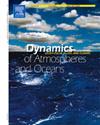南印度洋盐度最大值区混合层温度和盐度的年际变化
IF 2
4区 地球科学
Q2 GEOCHEMISTRY & GEOPHYSICS
引用次数: 0
摘要
利用ECCOv4r4和Argo观测资料,探讨了南印度洋(SIO)盐度最大值区混合层温度(MLT)和盐度(MLS)的年际时间尺度变化。在南方夏冬季节,MLT和MLS与地表热通量和蒸发变化呈串联关系。尽管SIO高盐度的月变化表明高盐度核心主要位于30°S附近,但在30°S以南有显著的季节变化,该区域的MLT年际变化比MLS高。协方差分析和收支分析表明,净热通量是影响混合层热收支的主要因素。然而,MLS的变化主要归因于经向平流和夹带。此外,MLT变率分为两个阶段(I) 1992—2006年,温度大多低于气候值;(II) 2007年以后,温度呈上升趋势,2010—2015年呈断续特征。在第1阶段,MLT趋势由经向平流驱动,然后是净热通量。而在第二阶段,净热通量主要驱动温度趋势,经向平流起次要作用。而盐度趋势主要由经向平流驱动。1992 ~ 2006年期间,由于风应力旋度的增强,向下的Ekman泵送导致混合层加深,而2006年以后,由于风应力旋度的减弱,MLD变浅。此外,在第二阶段,混合层经向速度的减少对该地区的增温和盐渍化有促进作用。本文章由计算机程序翻译,如有差异,请以英文原文为准。
Interannual variations of mixed layer temperature and salinity in the South Indian Ocean salinity maxima region
The study explores mixed layer temperature (MLT) and salinity (MLS) variability in the salinity maxima region present in the South Indian Ocean (SIO) on interannual time scale using ECCOv4r4 and Argo observations. It is observed that MLT and MLS are in tandem with surface heat flux and evaporation changes during the austral summer and winter seasons. Although the monthly evolution of high salinity in the SIO shows that the high salinity core is primarily located near 30° S, with notable seasonal variability south of 30° S. The region exhibits high interannual variability in MLT compared to MLS. Covariance and budget analysis show that net heat flux is the primary and significant component that contributes to the mixed-layer heat budget. However, changes in MLS are mainly attributed to meridional advection and entrainment. Furthermore, MLT variability is separated into two phases (I) 19922006, where the temperature is mostly below climatological value and (II) after 2007, the temperature is seen increasing with a hiatus-like signature from 20102015. During phase I, the MLT tendency is driven by meridional advection followed by net heat flux. However, in phase II, net heat flux mainly drives the temperature tendency, and meridional advection plays a secondary role. Whereas, salinity tendency is mainly driven by meridional advection. Further, in 19922006 period, downward Ekman pumping results from the strengthening of wind stress curl, led to the deepening of the mixed layer, while after 2006 MLD shoals due to weakening of wind stress curl. Additionally, during the second phase, the reduced meridional velocities in the mixed layer contribute to warming and salinification in the region.
求助全文
通过发布文献求助,成功后即可免费获取论文全文。
去求助
来源期刊

Dynamics of Atmospheres and Oceans
地学-地球化学与地球物理
CiteScore
3.10
自引率
5.90%
发文量
43
审稿时长
>12 weeks
期刊介绍:
Dynamics of Atmospheres and Oceans is an international journal for research related to the dynamical and physical processes governing atmospheres, oceans and climate.
Authors are invited to submit articles, short contributions or scholarly reviews in the following areas:
•Dynamic meteorology
•Physical oceanography
•Geophysical fluid dynamics
•Climate variability and climate change
•Atmosphere-ocean-biosphere-cryosphere interactions
•Prediction and predictability
•Scale interactions
Papers of theoretical, computational, experimental and observational investigations are invited, particularly those that explore the fundamental nature - or bring together the interdisciplinary and multidisciplinary aspects - of dynamical and physical processes at all scales. Papers that explore air-sea interactions and the coupling between atmospheres, oceans, and other components of the climate system are particularly welcome.
 求助内容:
求助内容: 应助结果提醒方式:
应助结果提醒方式:


